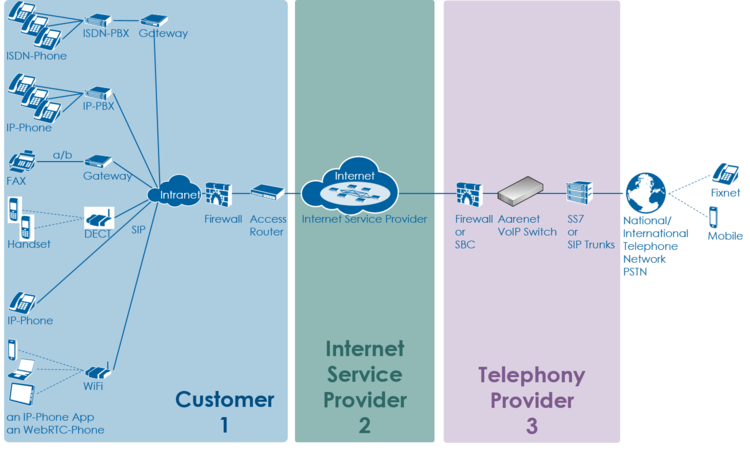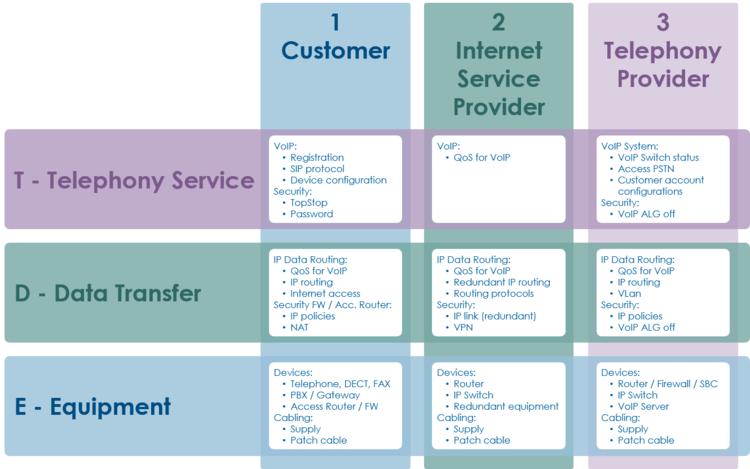Difference between revisions of "Support user level2"
| Line 16: | Line 16: | ||
<!-- PAGE BREAK --> <!-- PDF Creation Directive ---------------------------------------------------> | <!-- PAGE BREAK --> <!-- PDF Creation Directive ---------------------------------------------------> | ||
<!-- Transclusion : Article Begin -----------------------------------------------------------------><section begin=article /> | <!-- Transclusion : Article Begin -----------------------------------------------------------------><section begin=article /> | ||
| + | {{ToTop | SupportUserIntroSupportLevel2 }} <!--------------------------------------------------------> | ||
| + | = Introduction Support Level 2 = | ||
| + | |||
| + | The level 2 support is the first instance where the user's telephony problems are handeled that a user cannot solve himself. Additionally the level 2 supporter must be able to detect if the user problem is a "single" problem or if there is a large scale problem, that produces the same problem for multiple customers, e.g. data transfer problems in the Internet so that no VoIP call signaling is possible. | ||
| + | |||
| + | |||
| + | The level 2 supporter must be aware of the complexity of a VoIP system and the multitude of telephony solutions on the user side. Furhter he needs an understandig of: | ||
| + | :* IP networking | ||
| + | :* [[{{NAMESPACE}}:support_voip_protocol | VoIP protocols ]] SIP for signaling, SDP and RTP for speech transmission. | ||
| + | |||
| + | |||
| + | Overview of a VoIP system and the multitude of user telephony solutions:<br> | ||
| + | [[file:support_analyzing_3x3_equipment_setup_all_e.png |750px|frameless|left|link=| Overview of a VoIP system and the multitude of user telephony solutions]] | ||
| + | <br clear=all> | ||
| + | |||
| + | |||
| + | The level 2 supporter faces problems with the following layers: | ||
| + | # Equipment | ||
| + | # IP data transfer | ||
| + | # Telephony service | ||
| + | |||
| + | And each of this layer can be located into the following raw areas: | ||
| + | # Customer/User site | ||
| + | # Internet Service Provider ISP | ||
| + | # Telephony Provider | ||
| + | |||
| + | This layer and dividing into areas produces a "3x3 Support Matrix":<br> | ||
| + | [[file:support_analyzing_3x3_matrix_notes_e.png |750px|frameless|left|link=| 3x3 Support Matrix with notes]] | ||
| + | <br clear=all> | ||
| + | |||
| + | |||
| + | Within this "3x3 Support Matrix" the supporter can: | ||
| + | :* advice the customer what to do when the problem is located in the nodes 1-T, 1-D and 1-E | ||
| + | :* check the customer configurations on the VoIP Switch, node 3-T, and, if he has operator rights, adjust configurations. | ||
| + | |||
| + | For the other cases the level 2 supporter must be able to identifiy if: | ||
| + | :* the user must contact his ISP, due to possible Internet access problems | ||
| + | :* the VoIP System administrator must be involved, due to possible telephony service problems | ||
| + | These cases indicate mostly large scale problems! | ||
| + | |||
| + | |||
| + | |||
| + | |||
| + | |||
| + | |||
| + | |||
{{ToTop | SupportUserProblemAnalyzing }} <!--------------------------------------------------------> | {{ToTop | SupportUserProblemAnalyzing }} <!--------------------------------------------------------> | ||
= Analyzing the Customer Problem = | = Analyzing the Customer Problem = | ||
| + | |||
| + | |||
| + | {{Note | type=bestpractice | | ||
| + | |||
| + | |||
| + | Identify the customers problem | ||
| + | |||
| + | |||
| + | |||
| + | Check the big picture | ||
| + | |||
| + | |||
| + | |||
| + | Solve the customer problem | ||
| + | |||
| + | |||
| + | |||
| + | }} | ||
| + | |||
| + | |||
| + | |||
| + | |||
| + | |||
| + | |||
| + | |||
| + | |||
| + | |||
| + | |||
| + | |||
| + | |||
| Line 23: | Line 99: | ||
{{ToTop | SupportUserProblemReception }} <!--------------------------------------------------------> | {{ToTop | SupportUserProblemReception }} <!--------------------------------------------------------> | ||
| − | == | + | == Identifying the User Problem == |
The supporter finds here instructions how to handle a user's telephony problem and to find out the problem area. | The supporter finds here instructions how to handle a user's telephony problem and to find out the problem area. | ||
| − | [[file: | + | |
| + | |||
| + | |||
| + | [[file:support_user_problem_analyzing_e30.png |750px|frameless|left|link=| Work Flow for the Reception of User Problems]] | ||
<br clear=all> | <br clear=all> | ||
| − | <!-- | + | |
| − | + | ||
| − | + | ||
| − | --> | + | |
| + | [[file:support_analyzing_3x3_equipment_setup_residential_e30.png |750px|frameless|left|link=| 3x3 Support Matrix of User Problems]] | ||
| + | <br clear=all> | ||
| + | |||
| + | |||
| + | |||
| + | |||
| + | |||
| + | |||
| + | |||
| + | |||
| + | |||
| + | |||
| + | |||
| + | <!-- PAGE BREAK --> <!-- PDF Creation Directive ---------------------------------------------------> | ||
| + | {{ToTop | SupportUserProblemBigPicture }} <!--------------------------------------------------------> | ||
| + | == Check the Big Picture == | ||
| + | |||
| + | |||
| + | |||
| + | |||
| + | |||
| + | |||
| Line 99: | Line 200: | ||
{{ToTop | SupportUserProblemFaxTransmission }} <!--------------------------------------------------> | {{ToTop | SupportUserProblemFaxTransmission }} <!--------------------------------------------------> | ||
== Solve Problem: Disturbed FAX Transmission == | == Solve Problem: Disturbed FAX Transmission == | ||
| − | + | ||
Instruction how to solve interrupted FAX transmission, e.g.: | Instruction how to solve interrupted FAX transmission, e.g.: | ||
:* Fax transmission doesn't start | :* Fax transmission doesn't start | ||
Revision as of 12:43, 13 September 2017
| Note | The features and/or parameters listed in this article may not be available from your telephone service provider. |
|
|
|
|
|
Introduction
The supporter finds here instructions how to handle a user's level 2 telephony problems.
Contents
- 1 Introduction Support Level 2
- 2 Analyzing the Customer Problem
- 3 Solving the Customer Problem
- 3.1 Solve Problem: The User Device does not Register
- 3.2 Solve Problem: Incoming Connections are Failing
- 3.3 Solve Problem: Outgoing Connections are Failing
- 3.4 Solve Problem: Irregular Connection Release
- 3.5 Solve Problem: Disturbed Speech Transmission
- 3.6 Solve Problem: Disturbed FAX Transmission
- 3.7 Solve Problem: DECT Multi-Cell Handsets are not Working
Introduction Support Level 2
The level 2 support is the first instance where the user's telephony problems are handeled that a user cannot solve himself. Additionally the level 2 supporter must be able to detect if the user problem is a "single" problem or if there is a large scale problem, that produces the same problem for multiple customers, e.g. data transfer problems in the Internet so that no VoIP call signaling is possible.
The level 2 supporter must be aware of the complexity of a VoIP system and the multitude of telephony solutions on the user side. Furhter he needs an understandig of:
- IP networking
- VoIP protocols SIP for signaling, SDP and RTP for speech transmission.
Overview of a VoIP system and the multitude of user telephony solutions:

The level 2 supporter faces problems with the following layers:
- Equipment
- IP data transfer
- Telephony service
And each of this layer can be located into the following raw areas:
- Customer/User site
- Internet Service Provider ISP
- Telephony Provider
This layer and dividing into areas produces a "3x3 Support Matrix":

Within this "3x3 Support Matrix" the supporter can:
- advice the customer what to do when the problem is located in the nodes 1-T, 1-D and 1-E
- check the customer configurations on the VoIP Switch, node 3-T, and, if he has operator rights, adjust configurations.
For the other cases the level 2 supporter must be able to identifiy if:
- the user must contact his ISP, due to possible Internet access problems
- the VoIP System administrator must be involved, due to possible telephony service problems
These cases indicate mostly large scale problems!
Analyzing the Customer Problem
| Best Practice |
Check the big picture
Solve the customer problem
|
Identifying the User Problem
The supporter finds here instructions how to handle a user's telephony problem and to find out the problem area.
Check the Big Picture
Solving the Customer Problem
Solve Problem: The User Device does not Register
Instruction how to find out and solve why the user's device cannot register, e.g.:
- Defect or not powered user device
- User device not correct connected to the IP network
- User device not correct configured
Solve Problem: Incoming Connections are Failing
Instruction how to solve failing incomming connections, e.g.:
- User device not correctly registered
- Wrong calling number
- User device not correct configured
Solve Problem: Outgoing Connections are Failing
Instruction how to solve failing outgoing connections, e.g.:
- User device not correctly registered
- Wrong called number
- User device not correct configured
Solve Problem: Irregular Connection Release
Instruction how to solve irregularly released user connections, e.g.:
- Failing Session Timer
Solve Problem: Disturbed Speech Transmission
Instruction how to solve disturbed speech transmission, e.g.:
- Short interruptions during the connection
- No transmission in one direction from the beginning of the connection
- No transmission in both directions from the beginning of the connection
Solve Problem: Disturbed FAX Transmission
Instruction how to solve interrupted FAX transmission, e.g.:
- Fax transmission doesn't start
- Not all pages are transmitted
Solve Problem: DECT Multi-Cell Handsets are not Working
Instruction how to solve problems with DECT Multi-Cell handsets, e.g.:
- Hand over from cell to cell not working
- Bad speech quality
© Aarenet Inc 2018
Version: 3.0
Author: Aarenet
Date: May 2017